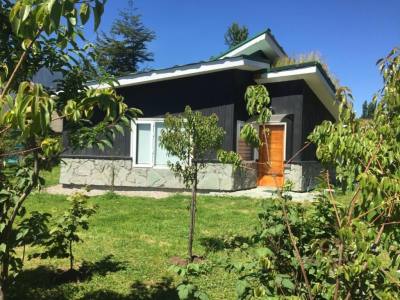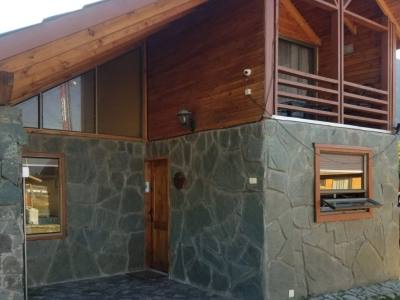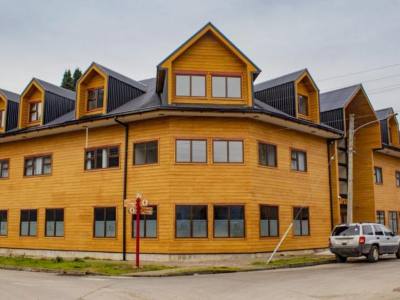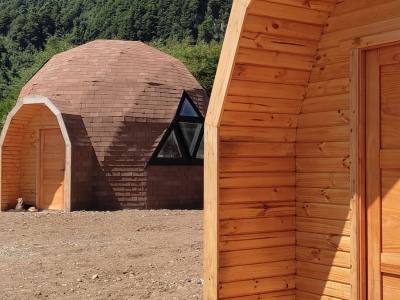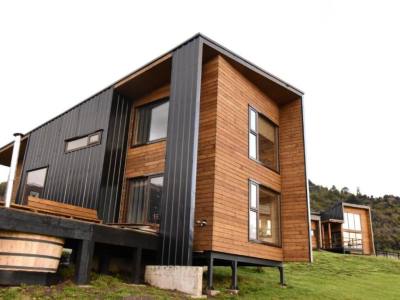
Touring around its streets, we were amazed to see the evergreen spaces enclosed by the mountains, the proximity to spots of matchless beauty and its people always willing to help visitors.
With a unique geography indeed, we slowly got deep into the very busy streets of
Puerto Aysén, where daily routine is quite intense. We were impressed by the great number of vehicles and the commercial pace that barely decreases at noon. When the temperature goes up, each denizen interrupts their morning activities and goes back home for lunch. We appreciated this delicate balance between work and home life. The presence of the Aysén River, its green banks and the huge suspension bridge joining both areas of the city were the elements that caught our attention. In the city, everything lies at a close distance: the main streets, the restaurants, the sights. It was easy to see the details of its structure without moving about too much. A high place,
cerro Mirador (Viewpoint hill), let us watch everything from above: the downtown area, the port and the river. One of the accesses lies on Merino Street. Following the same street, we headed for the footbridge leading to Díaz Island. We found a green land surrounded by the river, some fishing boats and a vast view of the mountain range that surrounds the city. We toured around its entire surface and enjoyed it leisurely. We saw the stage where shows are presented outdoors. The anniversary of the city is in January and celebrations are held at this spot. We pictured ourselves sitting there waiting for sunset and chatting with friends or just hiking. We made a stop in the shade of some old leafy trees that dressed up the main square. On the canopies of walnut trees and conifers, countless birds started a concert as we arrived. We had a look at the main buildings around: the provincial government building, the banks, the town hall and the cathedral church.

Omega 3
At any corner in town, nature in unimaginable green shades is the common denominator, and so is the mark left by fishing activities from former times. A settler told us: “Until the 1950s, the port of Aysén used to be accessible for large deep-draft vessels and fishing industries contributed to the economic growth of this area. Later on, erosion had an impact on the riverbed and only smaller boats could get to port”. Many of them, with their ancient wood of a thousand colors, were moored at
puerto de Aguas Muertas (dead waters port), which we accessed through O’Higgins Street. They were waiting for the high tide in order to get out of the Aysén estuary out to sea. Tough men, used to challenging the wind and the waves, were performing the maintenance tasks trusting that good fishing would justify the effort. They moved at the rhythm of the music from the Chilean islands and fjords in the background. We continued down O’Higgins Street towards Lake Los Palos and its port. A zone of sudden changes in the vegetation and the mountains, with plenty of rock at sight. In this wilder area, the air was fresher. We ended the sea tour with the image of Saint Peter, patron saint of fishermen. We slowly returned to the center of town and walked along the main commercial street, namely Sargento Aldea. Once again, the rumor of a city that lived, acted and developed with vigor. Its wide sidewalks offered comfortable wooden benches to sit down and have a rest. During our excursion, we found traditionalist centers. The riders and cattle-drivers from Puerto Aysén, proud of their customs, get ready every year to take part in the traditional festivals of Mañihuales or Villa Cerro Castillo with rodeo shows and lamb grilled in a metal cross on an open fire.

Sometimes on foot and sometimes driving, we almost finished our tour around the city and left an architectural jewel to watch at the end. It joins both banks of the Aysén River. It is Presidente Ibáñez suspension bridge. Considered one of the longest in Chile, it was declared Historical Monument and its two 25-meter-high metallic arches and its strong steel cables offer a show of the power and stiffness that makes contrast with the green nature around. Curiously enough, our visit ended at the sign reading “Welcome” at one of the ends of the bridge, where the craftsmen have their stands. It had not been necessary to read it as we entered this town. During the entire tour we felt completely at ease in this wonderful city.















